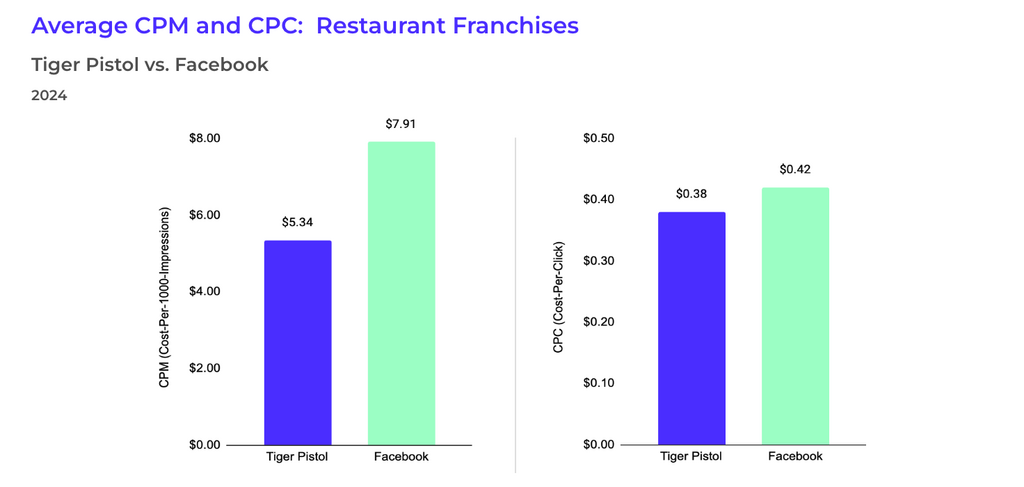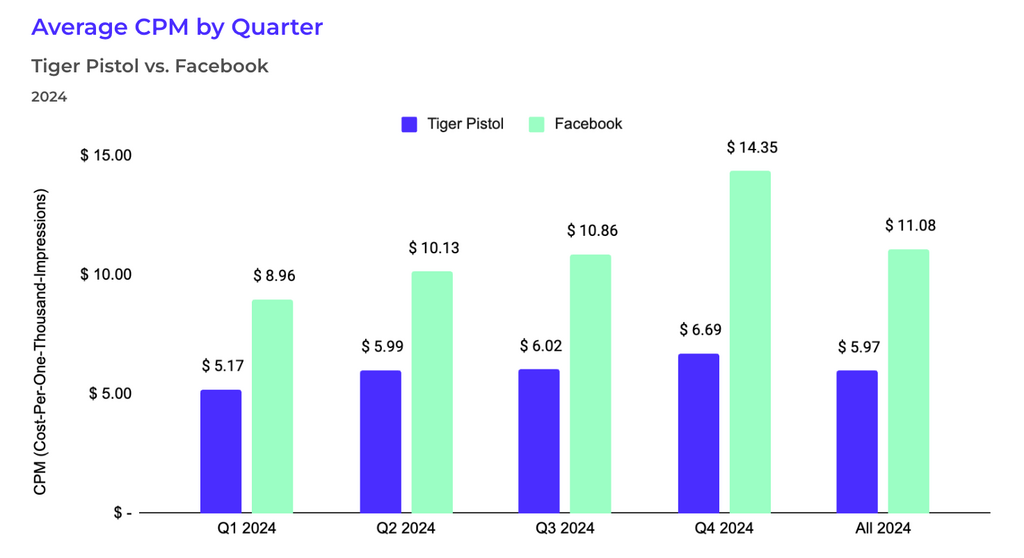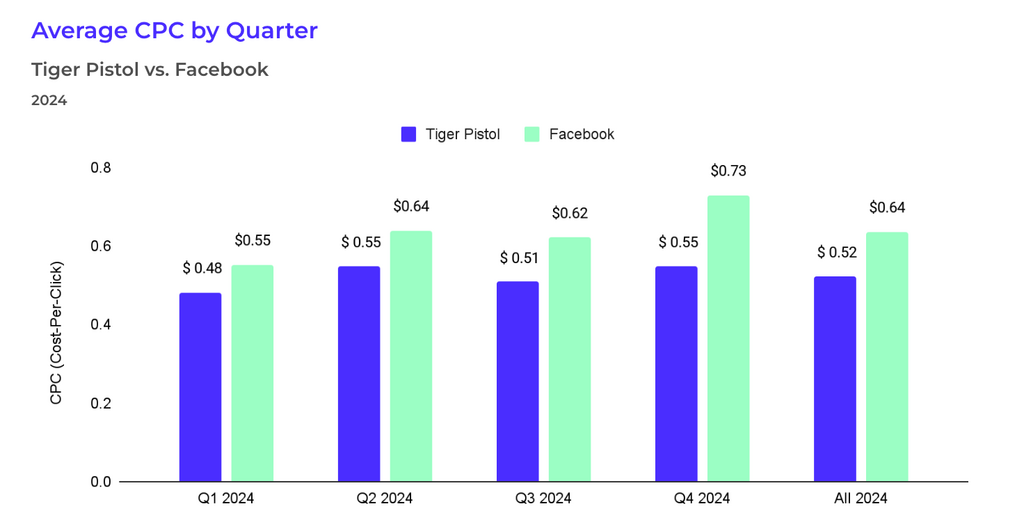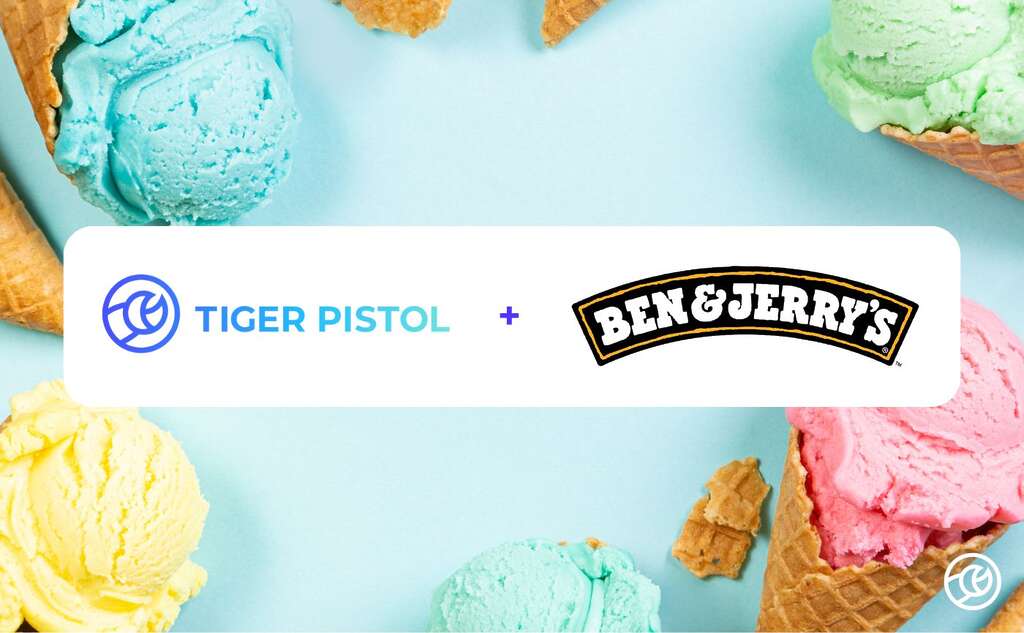How Restaurant Franchise Brands Outperform Facebook Benchmarks with Local Advertising
Restaurants rely on consistent foot traffic and repeat customers to thrive, but national campaigns often fail to capture local dining trends, special events, or seasonal promotions. For franchises and multi-location restaurant brands, reaching the right audience at the right time is critical to driving reservations, takeout orders, and in-store visits.
With Tiger Pistol’s localized advertising approach, restaurant brands can deploy hyper-targeted campaigns that deliver stronger engagement and cost efficiencies. Restaurants using Tiger Pistol’s platform achieve:
- 39% lower CPM than Facebook, making brand awareness campaigns more affordable.
- 10% lower CPC, helping restaurants drive more website visits, reservations, and orders.

By focusing on locality, restaurants can engage diners with relevant messaging, special offers, and promotions tailored to their specific markets. Whether promoting a lunch special, a new seasonal menu, or a loyalty program, localized advertising ensures restaurant brands stand out in a crowded digital space and remain top-of-mind for local diners.
Across all industries, Tiger Pistol’s local advertising platform consistently delivers more cost-effective results than Facebook’s benchmarks. Even during peak advertising seasons like Q4, Tiger Pistol ensures cost stability, with only a 10.5% increase in CPM compared to Facebook’s 28% surge.


Tiger Pistol’s localized approach to social advertising consistently outperforms Facebook’s Business Manager by improving efficiency and engagement while lowering costs.
For franchise and multi-location restaurants, scalable local advertising is the key to sustainable growth. By running ads from local business pages rather than a national brand account, restaurants build credibility, drive more direct engagement, and ensure promotions are relevant to each market. Tiger Pistol’s platform empowers brands to maintain centralized control while giving individual locations the flexibility to promote menu items, events, and offers that resonate with their local customer base. With a localized strategy, restaurant brands can fuel consistent foot traffic, increase orders, and strengthen long-term customer loyalty.
Learn how Wendy’s streamlined franchisee social campaign management – centralizing control while unifying data across regions
Learn how Ben & Jerry’s boosted delivery orders with location-targeted, Uber-Eats coupon campaigns – turning local ads into real sales.
Discover how Tiger Pistol can power your local advertising success.
Related Posts
How Beauty and Wellness Brands Outperform Facebook Benchmarks with Local Advertising
Beauty and wellness thrive on personal connections and visual storytelling. However, many national campaigns fail to capture the localized nuances that drive engagement and sales. For franchises and multi-location Beauty and wellness businesses, this gap can mean missed opportunities for deeper customer connections and higher conversion rates. Tiger Pistol̵
Revolutionize Marketing Accountability with Local Advertising
Marketing accountability has transformed thanks to tech advancements, shifting business priorities, and the demand for improved ROI tracking. In earlier times, marketers honed in on surface-level metrics like impressions and reach, which failed to truly show a campaign’s effect on profits. But times have changed. A Capgemini study discovered that over 75%
Franchisee Engagement: Empowering Franchisees to Thrive in Local Marketing
Franchisees are highly skilled at managing their businesses, but many find themselves struggling when it comes to marketing. According to the IFA report, 57% of franchisees are single-unit owners, many of whom lack the time and digital marketing expertise necessary to run effective local advertising campaigns. These business owners are focused on operations,
Brand Integrity and Agile Marketing with Local Social Advertising
A brand represents not merely a logo, but a commitment to quality and reliability for consumers. Yet, the involvement of franchisees introduces significant challenges in maintaining brand consistency and compliance. Any misalignment can damage the brand’s reputation and erode consumer trust, resulting in decreased sales. Local social advertising offers a







